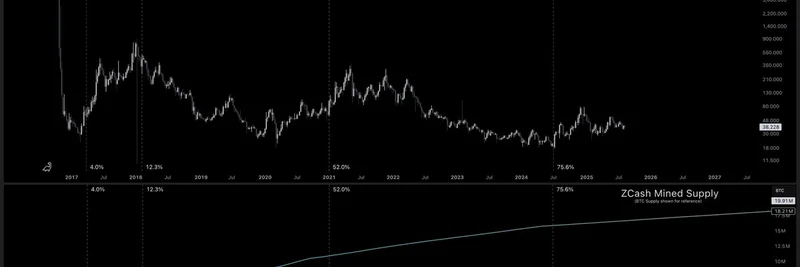Hey there, crypto enthusiasts! If you've been keeping an eye on privacy coins, you might have noticed Zcash ($ZEC) lingering in the shadows for a while. But according to a recent deep dive by analyst Beary on X, things could be about to change dramatically. In his thread, Beary breaks down why Zcash's chart has looked suppressed for years and why evolving tokenomics might set it up for a big upward move. Let's unpack this in simple terms, explaining the key concepts along the way.
First off, what's Zcash? It's a cryptocurrency launched in 2016, designed for privacy using zero-knowledge proofs – basically, tech that lets you prove a transaction happened without revealing details like who sent it or how much. Like Bitcoin, it has a fixed supply cap of 21 million coins and halves its block rewards every four years to control inflation.
Beary points out two main factors shaping $ZEC's price: circulating supply and reward distribution. Unlike Bitcoin, where miners get all the rewards, Zcash sets aside 20% for the project. How that 20% is allocated has changed over time, and that's crucial.
From launch until November 2020, a big chunk – about 14.2% of rewards – went directly to founders, employees, and advisors. That's like giving early team members a steady stream of coins, which likely created ongoing sell pressure as they cashed out. After 2020, this shifted to funding organizations and community grants, with no more direct payouts to individuals. And come November 2025, another change is on the horizon, potentially ending the project fund altogether or restructuring it.
This table from Beary's thread shows the breakdown clearly. In the early days, that "Founder's Reward" was a hefty portion, front-loading supply to insiders. As issuance slows with halvings, this overhang becomes less relevant.
Now, let's look at the price history tied to supply. Beary's chart illustrates how $ZEC has navigated crypto cycles:
Launch (2016): Extreme volatility with tiny supply; price spiked to $30,000 on some exchanges before crashing.
2017 Bull: Supply at 4-12%, altcoins booming, peak around $900.
2018 Bear: Supply ballooned to 50%, price to $18 lows – tough times likely prompted selling.
2nd Cycle (2021): Slower supply growth post-first halving, but $ZEC underperformed newer coins, topping at $370 with heavy volume suggesting insider sales.
3rd Cycle (Now): After the second halving, 75% of supply is out, inflation is low, and Beary believes the early-holder selling is mostly done.
With 90% of total supply expected by 2030, the constant drip of new coins is drying up, potentially removing a key price suppressor.
Another exciting angle is Zcash's privacy features creating "illiquidity." Coins can be in a transparent pool (like Bitcoin, visible on-chain) or a shielded pool (private). Over 21% of supply is now shielded – off exchanges and hard to trade quickly. This chart shows the growth:
As more $ZEC hides in shielded addresses, liquidity thins out. That means any fresh demand – like from big buyers – could cause sharp price spikes. Beary speculates on catalysts, such as "treasury companies" (think firms like MicroStrategy for Bitcoin) adopting privacy coins. Barry Silbert's Grayscale already holds a big $ZEC bag via their trust, positioning him well to lead this narrative.
In summary, Zcash's tokenomics are maturing: less insider selling, slower issuance, and increasing privacy usage locking up supply. If demand picks up – perhaps from renewed interest in privacy amid regulatory scrutiny – $ZEC could see the kind of explosive rally we've witnessed in meme tokens, but backed by solid fundamentals. Keep an eye on this one; it might just surprise the market.
What do you think? Is $ZEC ready to moon, or are there risks we're missing? Drop your thoughts in the comments!



